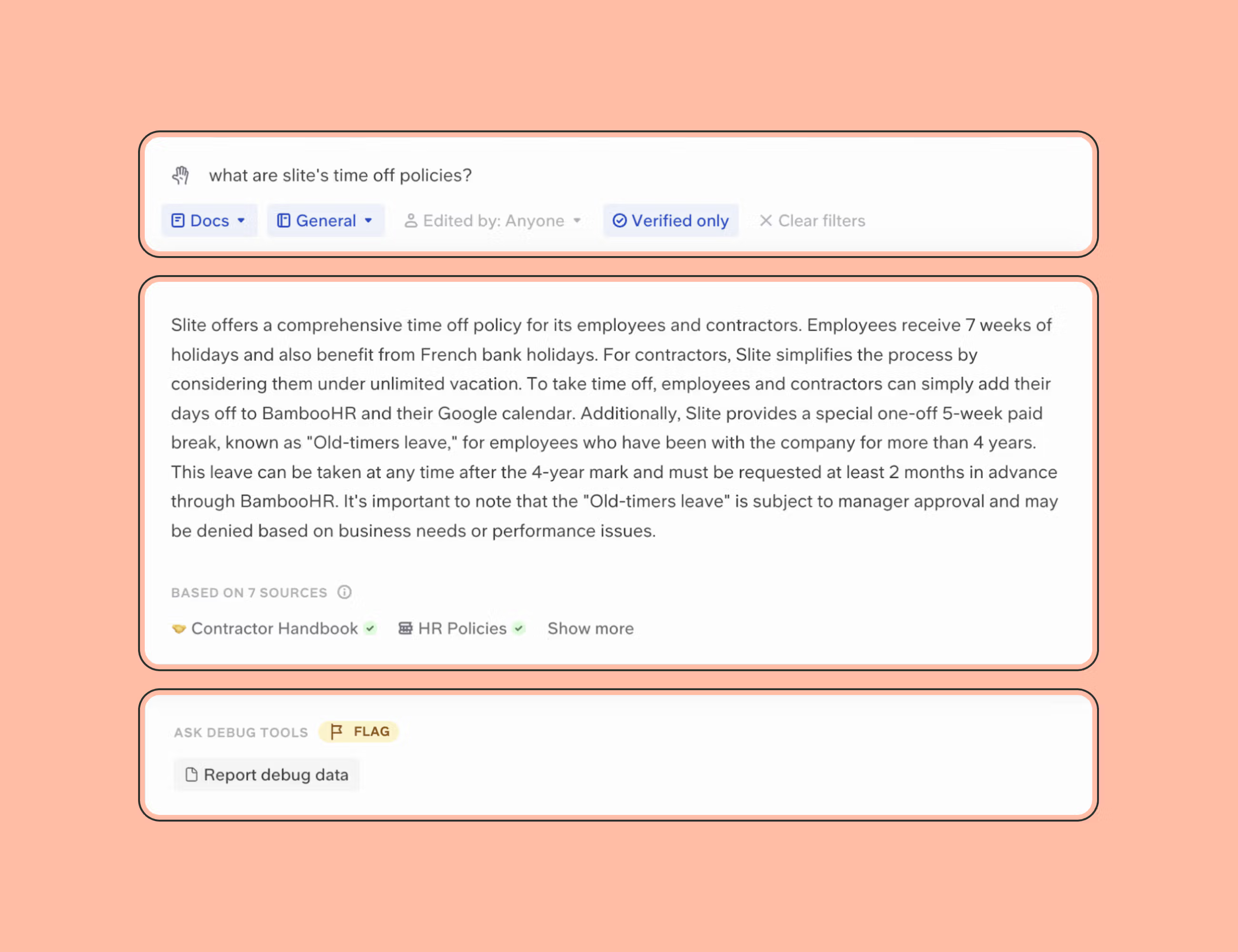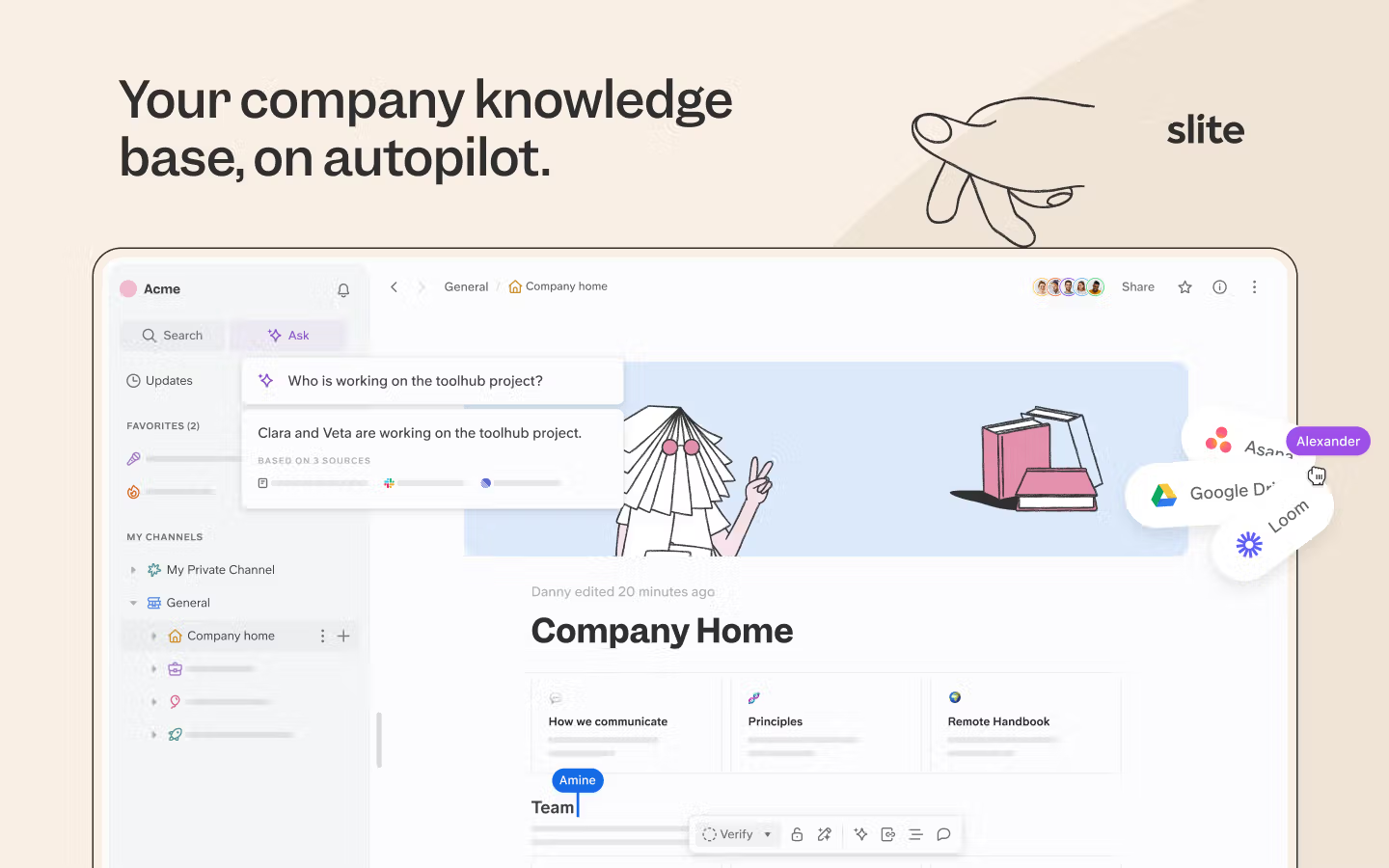Why do you need a Knowledge Base? Here’s why our customers did.

You already know the standard reasons of why you begun to look for a Knowledge Base.
Maybe you have a frontline team you need to support with information on the go.
Maybe you’re a founder with messy documents looking for a better way to manage docs.
Maybe you’re an HR team of 1 answering, “How to apply for PTO” 20 times a day.
There’s multiple reasons to get into a Knowledge Base. But there's also a budget optimising part of you that worries.
Will this actually make a difference to my team? How will I get the leadership buy-in? Is it even urgent enough?
We get these questions from our customers all the time. In the middle of budget cuts and you worrying about your Q3 plans - it's a hard decision to make. So, here's the main things you actually want to consider.
You don’t want to do the same work thrice
One of the biggest productivity killers in any organization is having to redo work that's already been done. But without a central knowledge base, this happens all the time.
Think about how often you've seen these scenarios play out:
- An SDR spends hours on a custom demo, not realizing that a similar one had already been created by someone else last quarter.
- A new marketing campaign is launched, but the designer has to start from scratch because they can't find the assets from the previous campaign.
- Customer support answers the same question over and over, because there's no easy way for customers or other employees to find the information themselves.
This is the problem that Slite solves. By providing a single, searchable repository for all your company's knowledge, it ensures that work doesn't get duplicated.
Take Commsor, for example. Before adopting Slite, they had a
"Sprawling mess of documents that were not connected" - Mac Reddin, Founder at Commsor
Team members would spend way too much time hunting down information or recreating docs they couldn't find.
But once all that knowledge was properly organized in Slite, everyone could easily tap into the work that had already been done. Meeting notes, project plans, sales enablement materials - it was all there, just a search away.
Imagine the hours saved from not having to reinvent the wheel every time. The efficiency gains from being able to say, "I know we solved this problem before, let me find that doc."
That's the power of an intentional knowledge base. It's not just about writing things down - it's about making sure all that hard work gets reused and built upon, instead of vanishing into the void.
You don't want to cut a steak with a Swiss army knife
It's possible. But you end up sawing away, mangling the meat, and making a mess. The same principle applies to managing your company's knowledge.
Many teams start out trying to make do with general purpose tools like Google Docs, Dropbox, or Notion. And while they're great for personal use, they quickly fall short.
You end up with a patchwork of docs, folders, and permissions that becomes hard to navigate and maintain over time. Important information gets lost in the cracks, buried in nested folders or stale documents that no one remembers to update.
Agorapulse, a team of 150+ people, felt this first-hand. When a team member joined the product, the team was already using a mix of Tettra, Google Docs, and Notion. All promised to be great all-in-one's but didn't get the right experience of a tool that focuses on Knowledge Management.
"What made me happy with Slite was that it was a very simple tool. It does documentation. That's it. That's what we need. We need documentation, we need to work asynchronously and synchronously, and that's it. The UI and UX were good. The price was good for us as well. We didn't need the whole machine like Notion was providing at the time. Once you have Notion you need an ops person who is just managing Notion. That's my understanding of how it works." -Sébastien Gendreau, Head of Product at Agorapulse
Use the right tool for the job. Just like you wouldn't cut a steak with a butter knife, don't try to manage your knowledge with tools that aren't designed for it. Are you using the right tools for the job? Or are you trying to cut a steak with a butter knife?
You don't want to lose hard-earned wisdom during lay-offs
When employees leave, they take with them not just their skills and experience, but also all the context and understanding they've built up over time.
- The intricate details of ongoing projects
- The nuanced relationships with key customers
- The hard-won lessons from past failures/experiments
When they leave, they create an informational blackhole. And it happens more often than you think. It happened to Omnisend too.
Omnisend, an e-commerce marketing platform, faced this challenge during their rapid growth phase. Their global team was expanding at a high speed but their onboarding process hadn't caught up.
"I joined at the moment where, within Engineering, there were around 15 employees. At the moment, we have around 80 or 90. And that growth happened in three to six months. So there was a lot of pain. A lot of things were being made, but no one — or at least the new engineers and product managers — knew how things were built, and what the logic was behind how our product operates." - Tomas Kazragis, VP Engineering at Omnisend
And Omnisend's case has echoed in multiple customer calls ever since. We repeatedly hear about problems like:
"We hired crazy fast but then 9 months later, we're all un-aligned and management is going crazy in catching up everyone on everything."
That's why, for high-growth companies, investing in Knowledge Management becomes even more important.
A shared memory allows new hires to contribute value from day one. Documenting product logic keeps consistency despite constant change. This knowledge continuity enables innovation at scale, avoiding institutional amnesia.
You want to make your frontline workers look good
In many industries, it's the frontline workers who are the face of the company. They're the ones interacting with customers, making sales, and delivering services. But too often, these critical employees are left without the tools and information they need to do their jobs effectively.
Consider a retail associate helping a customer find a specific product. Without easy access to up-to-date inventory information, they may end up making promises they can't keep, leading to a frustrated customer and a missed sale.
A lack of accessible knowledge slows frontline worker and stumps them in front of your consumers.
Your consumer expects them to have all the answers, all the time. And with the right Knowledge Management tools in place, frontline workers get that security and speed. This is the power of a well-designed knowledge management app.
By providing frontline workers with mobile-optimized access to the information and expertise they need, when and where they need it, companies can drastically improve their effectiveness and job satisfaction.
Of course, just having an app isn't enough - it needs to be thoughtfully designed with the end-user in mind. That means:
- Having a clean, intuitive interface that's easy to navigate on a small screen. We focused on this a lot while building Slite's mobile app.
- Implementing smart permissions to ensure each worker has access to the information that's relevant to their role, without being overwhelmed by irrelevant content
- Having an Enterprise Search that lets you ask natural questions, and answers just come up from verified company info.
That's a thing we wanted to nail while building Ask - Slite's AI search (included in all tiers, no AI add-on costs)

If you're a Slite user, you can
- Install the Slite mobile, the browser extension, and the Slack extension.

2. Ask questions like "What did the Marketing team do last quarter?" and get exact answers with citations.
So if you want to truly support your frontline workers - the ones who are out there every day, representing your brand and driving your business forward. And really, the benefits scale as your frontline team grows. Saved hours every week, turn into saved months over years.
You want your team to enjoy writing everyday
"Writing documentation is a very friction-intensive process. You need to make it as easy as possible to write it." - Alex Wiley, Head of Product at OneUp
When we spoke to hundreds of customers, including those who don't enjoy writing, we discovered specific reasons that kept most people from 'liking' business writing.
{{form}}
Our customers spent too much time painfully formatting their documents, so we built a 1-click auto-improve feature that structures and proofreads your document.
They wanted more than just a WYSIWYG editor because their work happened across multiple, focused tools.
Our customers wanted to start an in-line sketch in one block, embed a Figma board in the next, and include its accompanying Linear ticket to track the project, along with the Slack thread for context on where the project conversation started.

In Slite, you can do all of the above and so much more. Without shifting tools, or even having to leave the document. It makes you feel like you’re having fun.
In fact, a good writing experience was the final AHA moment that made Commsor go with Slite.
“One of those professional writers on our Content team basically was like, 'I like writing in Slite. I would actually prefer to write here than Google Docs.” - Mac Reddin, Founder at Commsor
So ask yourself - is your current solution a tad too boring? If so, you might never develop a true knowledge sharing culture. They’ll be stuck in the loop of only creating documentation at the last minute, without ever enjoying it.
You don't want your Knowledge Base to go outdated every 2 months
An outdated Knowledge Base can do a lot more damage than good. It can actually lead your team astray, causing confusion, mistakes, and wasted time.
This is common with all-in-one tools that try to be a jack-of-all-trades, but end up being a master of none. They may offer basic wiki functionality, but they lack the robust features needed to keep your knowledge fresh and relevant over time.
A good Knowledge Base should empower your team to:
- Easily verify the accuracy and currency of documents
- Have a go-to single place for updating and archiving all content
You only get such functionalities in dedicated Knowledge Base tools like Slite.
Ours is called the Knowledge Management panel. It gives you a comprehensive dashboard with filters that instantly show you which docs are outdated, which need verification from a team member, and which are empty or unread. You can slice and dice the data from there or dive deeper with specific queries. For example, you could ask Slite to "show me all empty docs from the last 4 months" and get a targeted list to clean up in one go.

So if you're tired of your Knowledge Base becoming a ghost town every few months, you definitely need a better app.
When verification becomes this easy, employees actually do it. And they finally start trusting their written knowledge.
Wording in CMSWording in CMSkWording in CMSWording in CMSWording in CMSWording in CMSWording in CMSWording in CMS
The bottom line
There’s the current way of doing things - get a question, disturb a colleague, get an answer.
And there’s a different way of doing things - build an intentional Knowledge Base, onboard your team, and make all of them more productive.
It’s challenging to do the latter. Especially when you’re in a fast environment.
So why do fast moving teams pick Slite?
And this is our finding: being in a fast environment is the reason you should invest in a good tool, even if it isn’t Slite. But Alex explains it best,
"In a world where everything feels so ephemeral, I think documentation can be a really nice permanent anchor, especially for a company. As you're growing, you need those anchors, in order to direct the ship." - Alex Wiley, Head of Product at OneUp
But once you opt into the philosophy of caring about documentation, there’s no going back.
Your team will thank you. Your customers will thank you. And you'll thank yourself for investing in a tool that doesn't just sit there, but actually works for your team.
When you think of the opportunity costs, and all the sunk cost in ineffective solutions; making a decision becomes incredibly straightforward. The question isn't whether you can afford to invest in Knowledge Management – it's whether you can afford not to.

Written by Ishaan Gupta
Ishaan Gupta is a writer at Slite. He doom scrolls for research and geeks out on all things creativity. Send him nice Substack articles to be on his good side.


